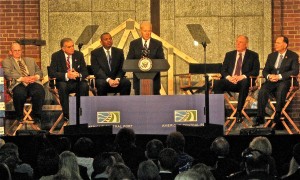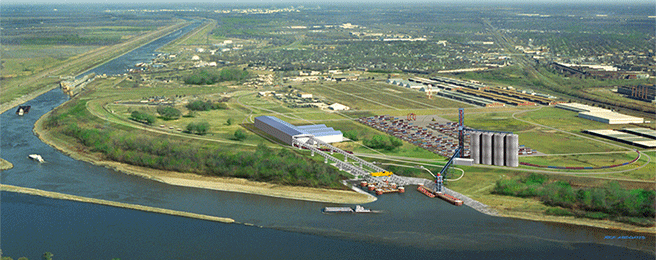
Anthony Foxx, (and to Biden’s left) Illinois Gov. Pat
Quinn and U.S. Rep. Bill Enyart (D-Belleville).
– Labor Tribune photo
By CARL GREEN
Illinois Correspondent
Granite City – Just north of downtown St. Louis, at a point where the south end of the Chain of Rocks Canal flows into the Mississippi River, lies America’s Central Port, the nation’s third largest inland port and the northernmost port on the Mississippi.
There, barge loads can meet up with railroad cars or trucks, providing a perfect setting for the factories and warehouses that rely on them.
The port has been a feature of Granite City for many years, but its utility will expand greatly this fall when its South Harbor project is completed, providing new transportation connections at a highly accessible location with no locking needed all the way to New Orleans.
This wouldn’t be happening, though, if the federal government hadn’t provided $14.5 million in seed money through the American Recovery and Reinvestment Act of 2009.
Vice President Joe Biden trekked to Granite City last month, on the fifth anniversary of the stimulus package, to celebrate the port’s success as an example of how public funding for infrastructure is a great investment for the nation.
“What you do here is incredibly important,” Biden told about 300 local residents and union leaders gathered inside a chilly warehouse, as he explained that South Harbor will handle up to 2 million tons of shipping a year. The funding was through a grant called Transportation Investment General Economic Recovery or TIGER.
“That means jobs, and not just here, but the jobs in factories that are shipping through here,” he said. “Without the TIGER money, you couldn’t do it. There is no reasonable way it could have been done. These are the kinds of things we should do – no matter what.
“This is worthwhile and important to do to stay competitive internationally into the next century.”
STARTING WITH LABOR
Early in his speech, Biden acknowledged other elected officials on the podium and then thanked everyone who was present from the union community, drawing strong applause.
“You know, there’s an old expression back my way – you go home with them that brought you to the dance, and the folks who brought me to the dance were the Longshoremen, the Seafarers, the Steamfitters, the Plumbers, the Pipefitters, Ironworkers, Laborers, Operating Engineers, Bricklayers, Steelworkers.
“That’s the only reason I’m standing here today as Vice President, and I could never have been elected without them,” Biden said. “They also are not only the backbone of American industry, but the spine. I’m glad you guys and women are having an opportunity to do what you do best – build, build!”
Also speaking were U.S. Secretary of Transportation Anthony Foxx; his predecessor, Ray LaHood, who helped put the South Harbor funding together; Illinois Gov. Pat Quinn; and U.S. Rep. Bill Enyart, a Belleville Democrat.
The story that emerged from their various remarks is that the much-maligned Recovery and Reinvestment Act was actually a roaring success that Biden credits for keeping the Bush-era recession of 2008 from becoming another Great Depression.
Biden recalled that the nation had already lost 9 million jobs on the day he and President Obama took office, and the newly elected officials were informed that millions more would soon be lost.
GREATEST RECOVERY
Instead, the nation experienced the greatest recovery since the Depression era, fueled greatly by public works projects such as South Harbor, funded by the $787 billion Reinvestment Act, which is now credited with creating 1.6 million jobs over four years.
“What we did was, essentially, to prime the pump,” Biden said. “Business goes where infrastructure exists. It brings down the cost of transportation, and it attracts people. It’s such a huge bang for the buck.”
Enyart described it this way: “These investments are like investing in your home by putting on a new roof. We can’t rest until every Main Street in southern Illinois is recovering.”
COSTELLO APPLAUDED
LaHood and Biden lauded the efforts of former U.S. Rep. Jerry Costello, a Belleville Democrat who pushed tirelessly for the South Harbor project to be included.
“I’m not sure we’d be here today if it weren’t for Jerry,” Biden said. “This was the beginning of a renaissance.”
Costello, who was present, got a nice round of applause.
Quinn complimented Biden for keeping his focus on creating jobs, especially for returning soldiers. “When they come home, we want to make sure they have good health care and good jobs,” he said. “The best way to fight poverty, the best way to fight crime, is a JOB. And that’s what our Vice President is all about.”
Biden said he was hopeful for the future.
“I’ve never been more optimistic than I am today,” he said. “I’m optimistic because the answers to our problems are not that complex. Just unleash the potential of Americans to do whatever has to be done to rebuild this great country.”

– Geotechnology Inc. photo
Port’s economic impact continues to grow
In 2002, the Tri-City Regional Port District took on a big job – transforming the former U.S. Army Charles Melvin Price Support Center into public port facilities, now known as America’s Central Port.
An economic impact report last year by RSN Economic Group Inc. concluded that the port has an annual economic impact of more than $282 million, up 36 percent since a similar study was made in 2007.
The port also supports some 1,450 jobs, either directly or indirectly, with more than $70 million in total labor income.
State and local taxes total $10 million, including $2.2 million in local property taxes.
According to the report, the port loads and unloads 2,500 barges a year, with transfers to rail and trucks of agricultural products, steel, fertilizer and asphalt. It also provides warehousing, foreign trade zone operations, industrial property and both residential and office space.
“The $282 million overall economic impact of the America’s Central Port places it among the major engines of economic development in (Madison) County,” said Dr. John Navin of RSN. “Other major contributors are Southern Illinois University Edwardsville and St. Louis Regional Airport.”
Biden gives a history lesson
“Americans have always believed there wasn’t any physical impediment they could not conquer,” Vice President Joe Biden told union, business and political leaders in his visit to America’s Central Port last week. “That’s what made us the great economy in the world.”
Reaching back into American history to show how investments in infrastructure have moved the nation forward, Biden noted:
• In 1806, a bipartisan group of officials made the bold decision to invest scarce resources in the National Road, which greatly expanded the nation’s horizons.
• In 1808, the State of New York embarked on another massive project, the 363-mile Erie Canal that eventually led to more than 2,000 miles of inland waterways.
• In the midst of the Civil War, President Abraham Lincoln demanded that Congress allocate funds to pay railroads to create a cross-continental rail line that later helped to open up the West.
• In the 1950s, President Eisenhower introduced the largest public works project the nation has ever seen – the interstate highway system.
“Imagine where we’d be if he hadn’t made that investment,” Biden said.

